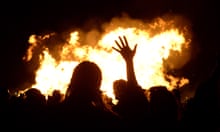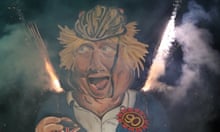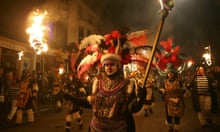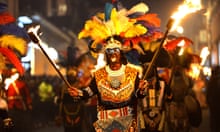Even by the standards of a town that sees itself as a bastion of English Protestant folk culture, it was a febrile lead-up to this year’s Bonfire night in Lewes. Each November this East Sussex town boards up its many shop windows and closes all surrounding roads, as tens of thousands of spectators converge on the high street.
A huge firework display culminates in a ceremonial blowing up of an image of Pope Paul V, the pontiff when Guy Fawkes and his band of Catholic revolutionaries came up with the gunpowder plot in the first years of the 17th century.
At the event, held on Saturday rather than 5 November – to keep the Sabbath sacred – one of this year’s must-see effigies was a giant, tweeting Donald Trump, pursued by a missile-brandishing Kim Jong-un. But the 2017 version of Guy Fawkes night has found itself dogged by an unexpected controversy. On Friday morning a last-minute decision was taken to end a long tradition of “blacking-up” for the occasion among supporters of the Borough Bonfire Society. A threatened boycott was thus averted, following a local campaign to stop what many saw as the offensive and outdated custom of dressing up as Zulu warriors.
It took the intervention of a genuine Zulu dancer from South Africa, who had been invited to join in, to get the costume plans finally changed. When Thanda Gumede from Durban was shown images of the black make-up used for 70 years in the Borough procession, he said they were a “gross misrepresentation and unacceptable stereotype of Zulu and black people at large”. Black face paint, nose rings, bones and skulls were then all dropped.
Beyond the costume row, though, this year felt a little special. The ancient anti-Catholic roots of the town’s Bonfire night festivities had acquired extra poke, coming so soon after Protestants around the world marked the 500th anniversary of Martin Luther’s doctrinal attack on the Vatican in Wittenberg. Public interest in the original significance of Bonfire night has also recently been stoked by the BBC’s lurid, big-budget drama Gunpowder, starring Kit Harington as the Catholic would-be terrorist Robert Catesby. This was the man who, alongside Fawkes, had drawn up the plot to blow up King James inside the House of Commons in the summer of 1605.
Last month television viewers complained that Gunpowder’s emphasis on the gruesome torture meted out to Catholic plotters was over the top. A harrowing scene in the first episode which showed a woman being crushed by weights caused particular shockwaves. Was this suitable family viewing? Yet similar horrors of persecution are the inspiration for the annual bonfire festivities in the comfortable dormitory town of Lewes. To be fair, the district council is clear where it stands: children are advised not to come.
Elderly residents do not enjoy it much either. “We will be indoors,” harrumphed one, while his neighbour warned visitors to buy earplugs because of the peril to eardrums when hundreds of firecrackers are set off.
Most of us may think Britain’s legacy of Christian religious violence belongs in history textbooks, but in Lewes the bitter memories are alive and well. Here, among the high street stores and dainty coffee shops, the townspeople repeatedly avenge the earlier burning at the stake of a group of Protestant martyrs.
In the mid-16th century, during the reign of the Catholic Queen Mary, Richard Woodman was burnt to death along with nine others outside the Star Inn in Lewes, now the site of the town hall. This human bonfire, lit on the orders of Edmund Bonner, bishop of London, was the largest of its kind to take place in England. Woodman was a victim of what is known as the Marian persecutions, committed under the reign of Bloody Mary. He had originally been arrested for criticising a rector for changing his sermon to suit the new Catholic monarch, Mary Tudor. As a result, Woodman was arrested and “examined” in London by Bonner, and by the bishop of Chichester and others, for the crime of daring “to worship God as the word of God directs”, as the martyrs’ memorial puts it.
The terrible fate of Woodman and his fellow martyrs is now marked in Lewes by six rival societies – Borough, Commercial Square, Southover, Waterloo, South Street and Cliffe, which each build their tableaux in secret to carry to their own bonfires.
By the end of the 16th century the tide had turned and Protestant dominance had been restored. Catesby’s plan to blow up his new king, who had, against expectation, exiled all Jesuits and Catholic priests, involved renting a cellar under the House of Lords and storing 36 barrels of explosives there. He told his fellow conspirator Thomas Wintour that he hoped to light a fuse that would destroy “the Parliament howse with Gunpowder… In that place have they done us all the mischiefe, and perchance God hath designed that place for their punishment”.
Before they could act, on the night of 4 November, Fawkes was discovered guarding the gunpowder, and the rebel game was up. Merging the traditional celebration of the Catholic plotters’ demise with a commemoration of the earlier Protestant martyrs was a relatively recent idea.
Jim Etherington, a local bonfire historian, points out that the martyrs were only commemorated in the town after 1901. “They brought them in to bonfire night after a memorial to the Sussex martyrs went up in 1901. They weren’t any part of it before then.”
On Saturday, after an anniversary year devoted to remembering Martin Luther’s Reformation, Lewes celebrated with as much relish as ever.









Comments (…)
Sign in or create your Guardian account to join the discussion